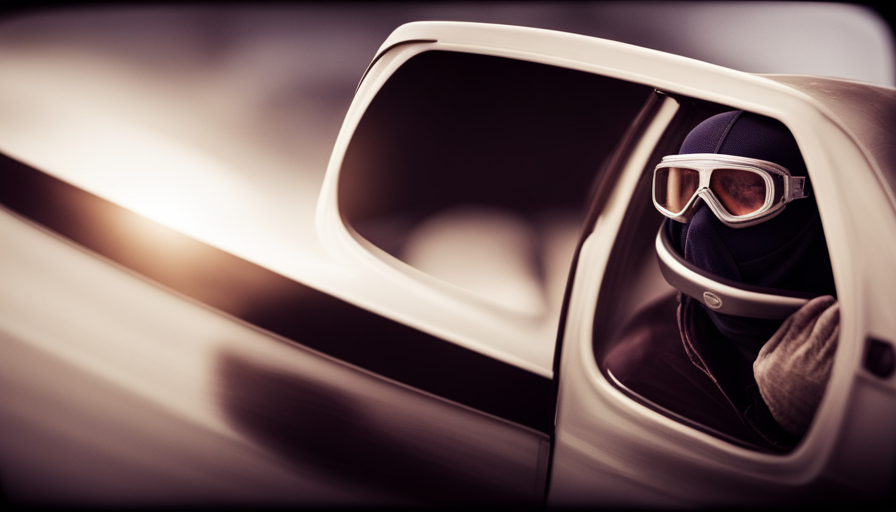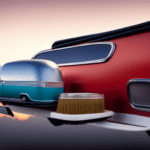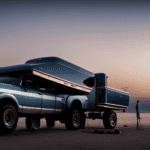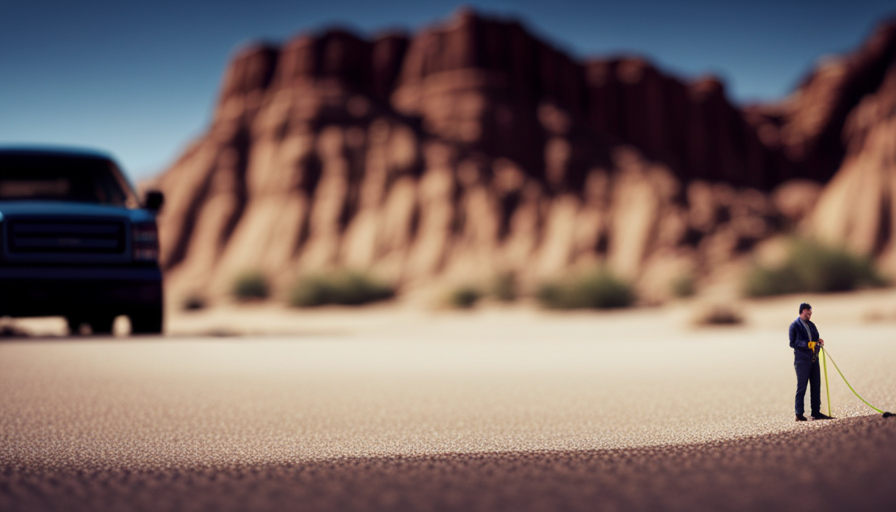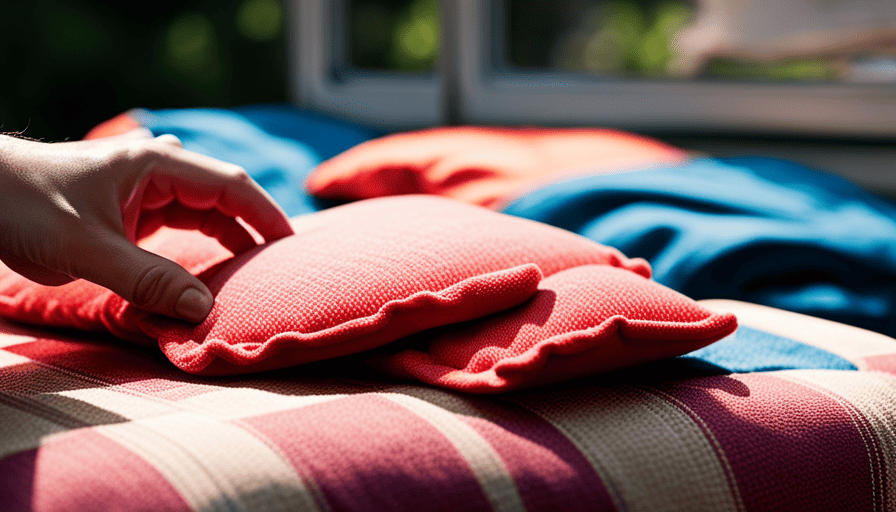Ever gazed upon a fiberglass camper shell and wished you could spruce it up with a fresh new look? You’re in for a treat! Painting a fiberglass camper shell is a fantastic way to transform its appearance and have it turn heads on the road. Ready to give your camper shell a makeover? Keep reading to find out how you can do it yourself with ease!
I remember when I first decided to tackle this project, I was a bit nervous about the process. However, armed with the right knowledge and materials, I was able to achieve a professional-looking paint job that exceeded my expectations.
In this article, I will guide you through the step-by-step process of painting a fiberglass camper shell. From preparing the surface to applying the final coat, I will share with you all the tips and tricks I have learned along the way.
So, let’s grab our paintbrushes and get ready to transform your camper shell into a work of art!
Key Takeaways
- Sand the surface and clean it thoroughly before painting.
- Use a primer specifically designed for fiberglass surfaces.
- Apply paint in thin and even coats to prevent drips or uneven application.
- Consider adding custom paint designs or patterns for a unique look.
Prepare the Surface
Now that you’ve got your fiberglass camper shell ready to go, it’s time to roll up your sleeves and start prepping the surface for the paint job. This step is crucial in achieving a smooth and long-lasting finish.
First, you’ll want to start by using sanding techniques to ensure that the surface is smooth and free of imperfections. Begin by sanding the entire surface with a fine-grit sandpaper, focusing on any rough areas or blemishes. Be sure to wear a dust mask and eye protection to protect yourself from the fiberglass dust.
After sanding, it’s important to thoroughly clean the surface to remove any dust or debris. Use a mild detergent and water solution to clean the shell, and then rinse it thoroughly with clean water. Allow it to dry completely before moving on to the next step.
Now that the surface is prepped and clean, it’s time to choose the right paint and supplies for your camper shell. This is an important decision, as you want a paint that is durable and will adhere well to the fiberglass.
In the next section, we’ll discuss the best paint options and the necessary supplies you’ll need for the job.
Choose the Right Paint and Supplies
First, make sure to select the appropriate type of paint and gather all necessary materials. Choosing the right paint for your fiberglass camper shell is crucial to ensure a long-lasting and professional-looking finish.
Look for paint that’s specifically designed for use on fiberglass surfaces. It should provide excellent adhesion and durability. Additionally, consider the colors you want to use for your camper shell. Whether you prefer a classic white or want to get creative with bold colors, make sure the paint you choose is available in the desired shade.
When it comes to safety precautions, always prioritize your well-being. Wear protective gear such as a respirator, safety goggles, and gloves to shield yourself from harmful fumes and chemicals. It’s also important to work in a well-ventilated area or wear a respirator to avoid inhaling any toxic substances.
To paint your fiberglass camper shell, you’ll need the following supplies:
- Primer designed for fiberglass surfaces
- High-quality paintbrushes or paint spray gun
- Sandpaper or sanding block
- Clean cloth for wiping down the surface
- Painter’s tape for masking off areas you don’t want to paint
With all the necessary materials gathered, we can now move on to the next step of the process: cleaning and sanding the camper shell.
Clean and Sand the Camper Shell
Before diving into the painting process, it’s crucial to give your camper shell a thorough cleaning and sanding, just like you would prepare a canvas before painting a masterpiece. Cleaning and sanding not only remove any dirt, grime, or old paint, but they also create a smooth surface for the new paint to adhere to. To achieve the best results, it’s important to use the right cleaning products and sandpaper.
For cleaning, I recommend using a mild detergent or automotive soap mixed with water. Avoid using harsh chemicals that may damage the fiberglass. Gently scrub the shell using a soft sponge or brush, paying attention to any stubborn stains. Rinse thoroughly and allow it to dry completely before moving on to sanding.
When it comes to sanding, the best sandpaper to use is a fine-grit sandpaper, such as 220-grit. This will help smooth out any rough patches and create a uniform surface for the paint. Start by sanding the entire surface of the shell in a circular motion. Be sure to pay extra attention to any areas with flaking or chipped paint. Once you’re done, wipe away any dust with a clean cloth.
Now that your camper shell is clean and sanded, it’s time to move on to the next step: applying primer.
Apply Primer
To achieve optimal adhesion of the new paint, it’s imperative that you apply a layer of primer to the surface of your meticulously cleaned and sanded canvas. Choosing the right primer is crucial as it’ll provide a smooth and even base for your paint to adhere to.
Look for a primer specifically designed for fiberglass surfaces, as it’ll have the best adhesion properties and durability.
Before applying the primer, make sure to read and follow the manufacturer’s instructions. Start by stirring the primer thoroughly to ensure an even consistency. Using a high-quality paintbrush or a paint sprayer, apply a thin and even coat of primer to the entire surface of the camper shell. Take your time and apply the primer in long, smooth strokes, overlapping each stroke slightly to avoid streaks or uneven coverage.
Allow the primer to dry completely according to the manufacturer’s instructions. This usually takes a few hours or overnight. Once the primer’s dry, gently sand it using a fine-grit sandpaper to create a smooth surface for the base coat.
Now that the primer’s applied, it’s time to move on to applying the base coat.
Apply the Base Coat
Now it’s time for me to give my project a vibrant and eye-catching makeover with a flawless base coat application. Choosing the right color for your fiberglass camper shell is an important decision. You want to select a color that not only complements your personal taste but also enhances the overall aesthetic of your camper. Whether you opt for a classic white or a bold and vibrant color, make sure to choose a high-quality paint that is specifically designed for use on fiberglass surfaces. This will ensure a smooth and long-lasting finish.
Before applying the base coat, it’s crucial to troubleshoot common issues that may arise during the painting process. One common problem is paint drips or uneven application. To prevent this, make sure to apply the base coat in thin and even layers, allowing each layer to dry completely before applying the next. Another issue to watch out for is paint bubbles or peeling. This can occur if the surface is not properly cleaned and prepared before painting. Be sure to thoroughly clean the camper shell, removing any dirt, grease, or old paint, and sanding down any rough spots.
Incorporating a 3 column and 5 row table, let’s take a closer look at how to troubleshoot common issues during the base coat application:
| Common Issue | Troubleshooting Steps |
|---|---|
| Paint drips or uneven application | Apply thin and even layers, allowing each layer to dry completely. |
| Paint bubbles or peeling | Thoroughly clean and prepare the surface before painting. Remove dirt, grease, and old paint, and sand down rough spots. |
With the base coat applied, it’s time to move on to the next step: adding design or patterns to your camper shell.
Add Design or Patterns
Get ready to unleash your creativity and transform your camper into a work of art with unique designs and patterns that’ll make heads turn. Adding custom paint designs or patterns to your fiberglass camper shell is a great way to personalize it and make it stand out from the crowd. With a little bit of imagination and some DIY techniques, you can create a one-of-a-kind masterpiece that reflects your personality and style.
Before you begin, make sure you’ve got all the necessary supplies, like paint brushes, stencils, masking tape, and a variety of colors. Start by sketching out your design on paper and then transfer it onto the camper shell using a pencil or chalk. This’ll help you visualize the final result and ensure that you’re happy with the placement and scale of your design.
Once you’re ready, start applying the base coat of paint using smooth, even strokes. This’ll create a solid foundation for your design and help it adhere to the fiberglass surface. Take your time and be patient, as this step’s crucial for achieving professional-looking results.
Now comes the fun part – adding your custom design or patterns! Use stencils, tape, or freehand techniques to create the desired shapes and lines. Experiment with different colors and textures to bring your design to life. Don’t be afraid to get creative and try new things – after all, it’s your camper and your chance to express yourself.
As you finish up the design, make sure to smooth out any rough edges or mistakes using a small brush or sponge. This’ll give your design a polished and professional look. Once you’re satisfied with the result, you can move on to the next step – applying a clear coat to protect and seal your design.
By incorporating custom paint and DIY techniques, you can transform your fiberglass camper shell into a true work of art. So, get ready to add your personal touch and make your camper a sight to behold. In the next section, we’ll discuss how to apply the clear coat to ensure that your design stays vibrant and protected for years to come.
Apply Clear Coat
Enhance the longevity and vibrancy of your unique design by sealing it with a clear coat. Applying a protective coating not only adds a glossy finish to your fiberglass camper shell, but it also helps to protect the design from fading or peeling over time.
Before starting the clear coat application, make sure the surface is clean and free from any dust or debris. Begin by stirring the clear coat thoroughly to ensure a smooth consistency.
Using a high-quality paintbrush or a spray gun, apply an even layer of clear coat over the entire surface of the camper shell. Make sure to work in small sections at a time to avoid any streaks or unevenness.
Once the first coat is applied, allow it to dry according to the manufacturer’s instructions.
After the initial coat has dried, lightly sand the surface with fine-grit sandpaper to remove any imperfections or bubbles. This will help create a smooth and flawless finish. After sanding, apply a second coat of clear coat and repeat the buffing process.
To achieve the best results, it’s essential to allow proper drying time between each coat. This will ensure that the clear coat fully cures and provides maximum protection for your camper shell design.
Allow Proper Drying Time
Patience is paramount when it comes to properly drying the layers of protective sealant on your beautiful design. To ensure a successful paint job on your fiberglass camper shell, it’s crucial to allow the proper drying time. Here are a few key points to keep in mind:
-
Importance of ventilation: Make sure the area where you’re drying the camper shell is well-ventilated. Proper airflow will help the sealant dry evenly and prevent any fumes from building up.
-
Avoid rushing the process: It can be tempting to rush the drying time, especially if you’re excited to see the final result. However, rushing can lead to uneven drying, which can ruin the finish of your camper shell.
-
Common mistakes to avoid: Don’t handle or touch the freshly painted surface until it’s completely dry. This can leave fingerprints or smudges on the sealant. Additionally, avoid exposing the freshly painted surface to direct sunlight, as it can cause the paint to dry too quickly and result in a less durable finish.
-
Give it ample time: Depending on the type of sealant used, drying times can vary. It’s essential to follow the manufacturer’s instructions for the specific sealant you’re using. Generally, allowing at least 24-48 hours of drying time is recommended.
With proper drying time, you can ensure a flawless finish on your fiberglass camper shell. Once the sealant is completely dry, you can proceed to the next step of reinstalling the camper shell seamlessly.
Reinstall the Camper Shell
Once the protective sealant on your design has dried completely, you can effortlessly reinstall the cozy home away from home onto your trusty travel companion.
Before reinstalling the camper shell, it’s important to reinforce its structure to ensure a secure fit. Check all the mounting brackets and hardware to make sure they’re in good condition and tighten any loose screws or bolts. This’ll help prevent any shifting or movement while you’re on the road.
In addition to reinforcing the structure, it’s also a good idea to consider weatherproofing options for your camper shell. This’ll help protect it from the elements and extend its lifespan.
One option is to apply a clear coat or wax to the painted surface. This’ll provide an extra layer of protection against UV rays, rain, and other environmental factors.
Another option is to install weather stripping along the edges of the camper shell to create a tight seal. This’ll help keep out moisture and prevent leaks.
By reinforcing the structure and considering weatherproofing options, you can ensure that your camper shell is securely installed and protected from the elements. This’ll help maintain and protect the paint finish for years to come.
Maintain and Protect the Paint Finish
To keep your camper shell looking its best, you’ll want to take steps to maintain and protect its beautiful exterior. Prolonging the paint longevity and preventing paint damage are crucial in ensuring that your camper shell remains in top condition for years to come.
First and foremost, regular cleaning is essential to maintain the paint finish. Use a mild soap and water solution to gently wash the camper shell, making sure to remove any dirt or debris that may have accumulated. Avoid using harsh chemicals or abrasive materials that can scratch or damage the paint.
Once the camper shell is clean, applying a high-quality automotive wax can provide an extra layer of protection. Waxing not only enhances the shine of the paint but also acts as a barrier against UV rays, pollutants, and other environmental factors that can cause fading or oxidation.
In addition to regular cleaning and waxing, it’s important to address any paint damage promptly. Scratches or chips in the paint can lead to further deterioration if left untreated. Invest in touch-up paint that matches the color of your camper shell and carefully apply it to the affected areas.
By following these maintenance steps, you can prolong the life of your camper shell’s paint finish, keeping it looking as good as new for many camping adventures to come.
Frequently Asked Questions
Can I paint my fiberglass camper shell without using primer?
Sure, you can paint a fiberglass camper shell without using primer, but it’s like trying to climb a mountain without a sturdy rope. Primer acts as a foundation, ensuring that the paint sticks and lasts longer. However, if you’re applying decals, you can skip the primer and use alternative priming methods like sanding and cleaning the surface.
Just remember, a little extra preparation goes a long way in achieving a professional and durable finish.
How long does the clear coat need to dry before I can reinstall the camper shell?
The drying time for the clear coat before reinstalling the camper shell can vary depending on the specific product you’re using. Generally, it’s recommended to wait at least 24 to 48 hours for the clear coat to fully dry. However, it’s always best to consult the instructions provided by the manufacturer of the clear coat for their specific recommendations.
This ensures that the clear coat has enough time to dry and cure properly, preventing any potential damage during reinstallation.
What type of paint is best for a fiberglass camper shell?
The best paint brands for a fiberglass camper shell are those specifically designed for use on fiberglass surfaces. These brands often include Rust-Oleum, Krylon, and Dupli-Color.
When painting a fiberglass camper shell, it’s important to prep the surface thoroughly by sanding it and applying a primer. Additionally, using a high-quality paint sprayer or a paintbrush can help achieve a smooth and even finish.
By following these painting techniques, you can ensure a professional-looking paint job on your fiberglass camper shell.
Can I apply a design or pattern to my camper shell before the base coat?
Yes, you can definitely apply a design or pattern to your camper shell before applying the base coat. One popular method is using decals, which are adhesive designs that can be easily applied to the surface. Another option is using stencils to create a more customized design. Both methods require careful application and attention to detail to ensure a clean and professional-looking result. It’s a great way to add a personal touch to your camper shell!
How often should I wax or polish my painted fiberglass camper shell for proper maintenance?
Maintaining the glossy exterior of your fiberglass camper shell is crucial for its longevity and aesthetic appeal. Think of waxing as a shield, protecting your camper shell’s paint job from the harsh elements it encounters on the road.
To ensure proper maintenance, I recommend waxing your painted fiberglass camper shell every three to six months, depending on your usage. Look for high-quality wax products specifically designed for fiberglass surfaces to achieve the best results and long-lasting protection.
Are the Steps for Painting a Fiberglass Camper Shell the Same?
Yes, the steps for painting a fiberglass camper shell are generally the same as painting any other fiberglass surface. It involves proper cleaning, sanding, applying primer, and then the actual painting. However, some additional measures may be required, like repairing cracks or applying gelcoat for better adhesion.
Conclusion
In conclusion, painting a fiberglass camper shell may seem like a daunting task, but with the right preparation and supplies, it can be a rewarding experience.
By cleaning and sanding the surface, applying primer, base coat, and clear coat, and allowing proper drying time, you can achieve a professional-looking finish.
Once the paint is dry, reinstalling the camper shell will bring a sense of accomplishment and a renewed sense of pride in your vehicle.
Remember to maintain and protect the paint finish to ensure its longevity.
Happy painting!

